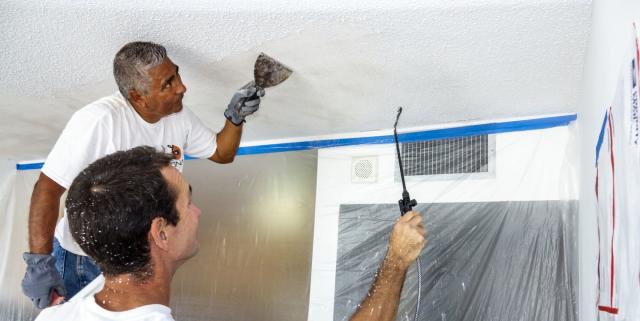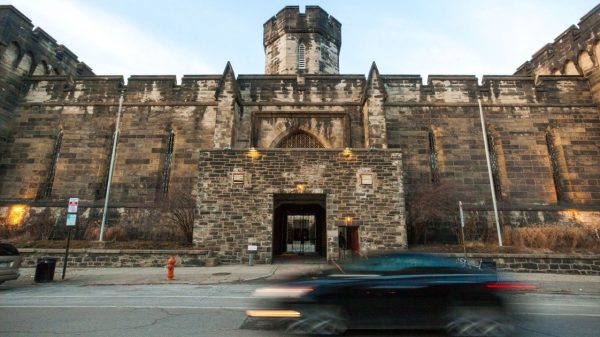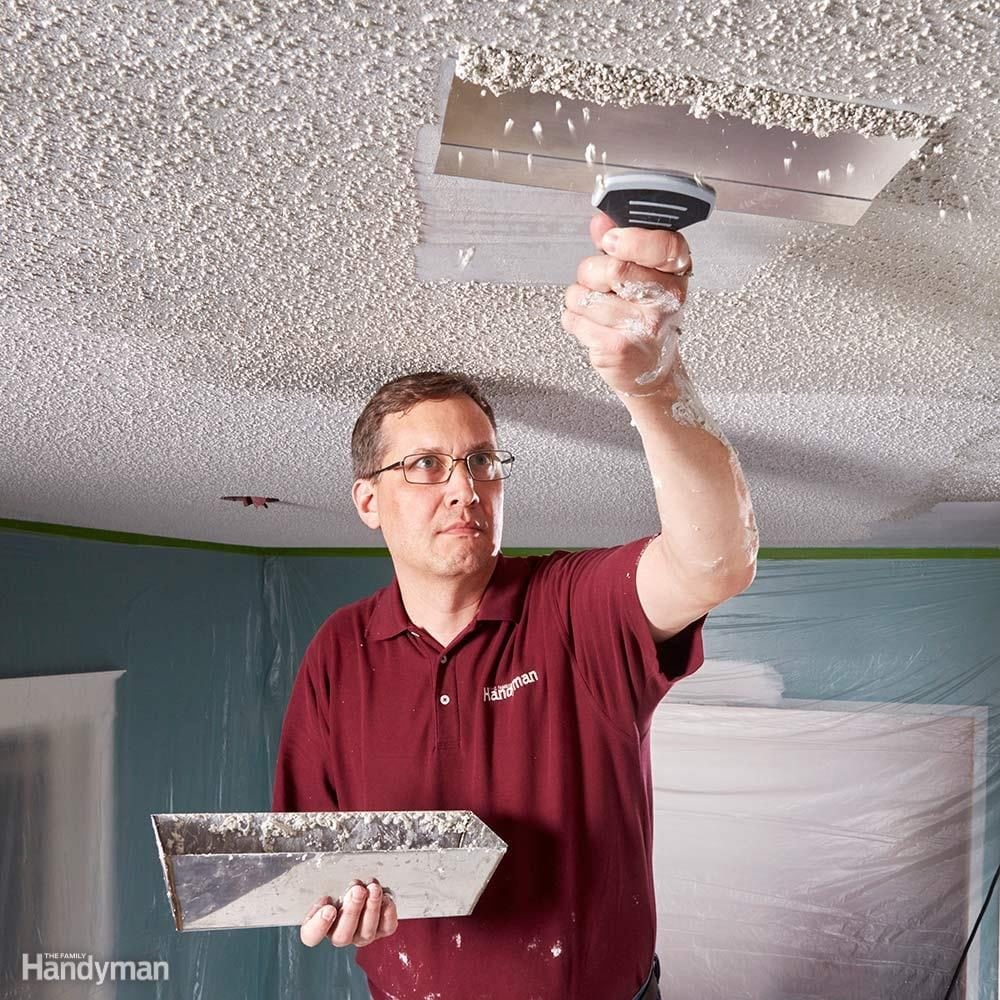Removing popcorn ceiling safely can save you both trouble and money. The removal process is usually not complicated, but certain aspects can make the job more difficult.
Removing popcorn ceilings can be a daunting task, especially if the ceiling contains asbestos. However, if you are certain that your popcorn ceiling is asbestos-free, the removal process can be quite simple. Here are some tips that can help you remove popcorn ceilings quickly and without any hassle.
Removing Popcorn Ceiling Steps
-
- Test for Asbestos
- Cover the Room for Protection
- Wet the Ceiling Surface Thoroughly
- Scape Out the Popcorn Ceiling
- Sand Down Uneven Areas
- Prime and Paint the Bare Ceiling
1. Test for Asbestos
Before removing a popcorn ceiling, it’s crucial to test for asbestos. If the ceiling was installed before the material was banned in construction work, there’s a possibility that it still contains asbestos, which can be harmful if inhaled. Testing for asbestos should be done carefully to avoid any exposure to the material.
Attempting to test for asbestos on your own is not recommended. Although there are do-it-yourself asbestos testing kits available for purchase, the accuracy of their results may differ between products. Additionally, handling the sample yourself can be hazardous. It is best to seek professional assistance for asbestos testing.
To ensure your safety, it’s important to have your ceiling tested for asbestos. Locate a nearby laboratory that offers asbestos testing services and inquire about their rates for a single sample. Donning protective clothing and a mask, carefully scrape off a small portion of your ceiling and send it in for testing. Keep in mind that results may take some time, so it is best to take action sooner rather than later.
It’s crucial to hire a professional removal service if your ceiling contains asbestos. Taking a DIY approach to asbestos removal is not recommended.
2. Cover the Room for Protection
Before beginning the process of removing a popcorn ceiling, it is important to take the necessary precautions to ensure that the room is fully protected. When scraping off the old popcorn ceiling, fine dust particles can easily spread throughout the room, even through small openings. Therefore, it is crucial to cover the room thoroughly with protective covers that can effectively isolate all areas, leaving no openings exposed. This will help to minimize the spread of dust and debris during the removal process.
When it comes to electronics, it’s crucial to take extra precautions during the removal process. To prevent any potential damage, consider removing them from the room altogether. Dust accumulation inside your computer can lead to a decrease in performance, so it’s essential to be mindful of this.
When removing covers, it’s crucial to secure them with tape to prevent any loose ends. This becomes even more critical when you start moving around the room. You don’t want to end up dragging one of the plastic sheets with you, so make sure everything is bound securely.

3. Wet the Ceiling Surface Thoroughly
Once the room is prepped, the next step is to wet the popcorn ceiling. Simply use a spray bottle filled with water and ensure that you cover the surface thoroughly. However, be careful not to damage anything beneath or above the ceiling surface while doing so. We’ll cover more on that later.
If you want to remove a popcorn ceiling, it’s best to wet it first. This will make the process easier for you. It’s recommended to work on the ceiling in patches to avoid drying out.
When spraying your ceiling, it’s important to consider the type of material it’s made of. If it’s susceptible to water damage, it’s best to work on smaller patches at a time and use minimal water. Avoid spraying the entire ceiling at once, as this can cause damage to materials such as wood, sheetrock, and other types of materials. So, be cautious and take care of the underlying material when spraying your ceiling.
4. Scrape Out the Popcorn Ceiling
When it comes to removing a popcorn ceiling, the first step is to ensure the area is wet. Once it is, grab a spackle knife and start scraping away the old ceiling. It should come off with relative ease, but be sure to maintain a safe distance from the area to avoid debris falling on you. Even if you’re wearing protective clothing, it’s still important to take precautions to make the cleanup process easier later on.
If the popcorn ceiling proves difficult to remove, don’t hesitate to apply some pressure, but be sure to protect the underlying surface. Since you’ll be painting over or covering it up, minor scratches are usually not an issue. However, damaging the ceiling may require repairs before any cosmetic touch-ups can be made.
5. Sand Down Uneven Areas
To get rid of popcorn ceiling, the next step is to smooth out any rough patches by going over the entire ceiling with sandpaper. Although a sander can be used, it may not be necessary as regular sandpaper can do the job just as well as long as enough pressure is applied.
When preparing to paint a ceiling, it’s crucial to be meticulous. Taking the time to thoroughly prepare the surface will make it significantly easier to paint over later on. If you intend to cover the entire ceiling, you can opt to skip this step. However, it’s still wise to apply a layer of primer for added protection, making sanding an essential step.








































